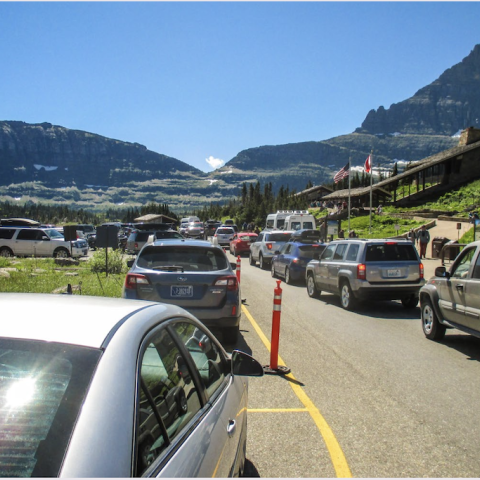
Explosives, not updated snowsheds, are being used to control avalanches above railroad tracks that parallel U.S. 2 along Glacier National Park's southern border/NPS file photo of snowsheds at work
Heavy winter snows have dangerously loaded the southern flanks of Glacier National Park in Montana, prompting the National Park Service to permit BNSF Railway to use explosives in the park to systematically trigger avalanches and reduce the risk that a slide would hit a passing freight or passenger train.
The permit allows the railroad to use hand charges, an "avalauncher," or other charges delivered by a helicopter during daylight hours in the John F. Stevens Canyon area along the U.S. 2 Corridor. The work could begin as soon as Tuesday (February 7). Railway traffic, including Amtrak trains, has been halted along the southern boundary of the park since Sunday. BNSF’s goal is to mitigate the avalanche hazard before the forecasted warming temperatures and rain arrive later this week, potentially further increasing slab instability.
The planned mitigation activity is the use of a DaisyBell®, with other charges delivered by a helicopter as a backup, a park release sent early Tuesday morning said. A DaisyBell® avalanche mitigation technique uses a cylinder suspended from a helicopter that can be positioned above the snowpack. It uses a small, controlled pressure wave from the sudden combustion of hydrogen to test slab stability or trigger the snow.
“We have received a significant storm through the region over the weekend, which has resulted in several avalanches. We are working with BNSF Railway to create safe conditions for their employees and passengers along the southern boundary of the park, and will continue to work with them to find long-term solutions," said Glacier Superintendent Jeff Mow.
Avalanche control along Glacier's southern border has spawned controversy in the past, with opponents saying the railroad could protect its freight trains and Amtrak passenger trains from slides by building additional snowsheds over its tracks. In 2008 the Park Service signed off on a plan that prevented railroads from routinely using explosives to clear avalanche chutes above the tracks. That decision came after BNSF officials sought permission to lob 105 mm explosives at key avalanche chutes in the area of Scalplock, Running Rabbit, Snowslip and Mount Shields mountains in John Stevens Canyon. That request came in the wake of a 2004 avalanche that caused a derailment.
As part of that 2008 decision, the Park Service allowed emergency avalanche mitigation efforts in the event that human lives or resources were at risk and after all other options have been exercised by the railroad, including train delays.
Snowsheds along the tracks long have been used by railroads to shield trains from slides, but the use of explosives is seen as considerably less expensive than maintaining the sheds. With freight trains running daily past Glacier, hauling upwards of 33,000 container cars a day to and from the Northwest, this section of track is a key route to keep open for commerce.
Just the same, the landscape targeted for bombing by the railroad is inside a national park and home to grizzly bears, mountain goats, wolverines, wolves, bald eagles, and other wildlife.
Glacier officials at the time recommended that BNSF construct additional snowsheds and to add on to existing ones in high-risk avalanche paths. However, the recommendation was an action that the National Park Service, the Flathead National Forest, and the Montana Department of Transportation do not have jurisdiction or authority to require BNSF to follow.
Two years ago the Park Service agreed to allow the railroad to use explosives in the same area to control slides.
Under the latest permit, BNSF is to work with the Montana Department of Transportation to determine the precise time of the mitigation effort and when MDT will close US Highway 2 to through traffic for the avalanche mitigation process, if it has previously been reopened to traffic. You can visit the Montana Department of Transportation website for current road conditions.
For updated information on avalanche hazard mitigation activities and related railway activities along the southern border of Glacier National Park, you can contact BNSF Railway at 406-256-4217 or at [email protected].




 Support Essential Coverage of Essential Places
Support Essential Coverage of Essential Places







Add comment